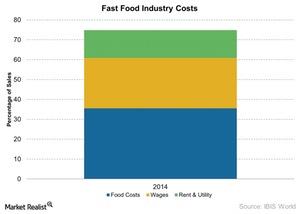How Commodities Play an Important Role in the Restaurant Industry
Agricultural and livestock commodities such as corn, coffee, beef, pork, chicken, and cheese play an important role in the restaurant business, as demand and supply factors impact prices.
July 9 2015, Published 4:39 p.m. ET

Agricultural and livestock commodities
Agricultural and livestock commodities such as corn, coffee, beef, pork, chicken, and cheese play an important role in the restaurant business. Food costs roughly account for about 30% of restaurant sales. McDonald’s (MCD) and Darden Restaurant’s (DRI) food costs account for 34% and 31% of sales, respectively.
The above chart shows three major costs for restaurants. Food is the biggest cost. Fluctuations in demand and supply factors of commodities impact prices and put pressure on food costs. This drives down margins and affects earnings.
It’s also negative for the Consumer Discretionary Select Sector SPDR Fund (XLY). XLY holds about 4% of McDonald’s, 3% of Starbucks (SBUX), and 1.5% of Yum! Brands (YUM).
Series overview
In this series, we’ll first look at beef prices, which affect companies that sell burgers, steak, and other beef varieties. Then we’ll look at how pork prices have done after the PEDV (porcine epidemic diarrhea virus) epidemic in 2013. We’ll also take a look at poultry prices. Affecting all these commodities is corn, because it’s used as feed for livestock. In the next part, we’ll take a close look at beef prices.
